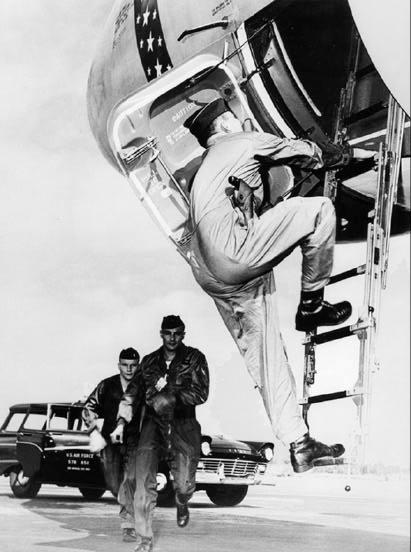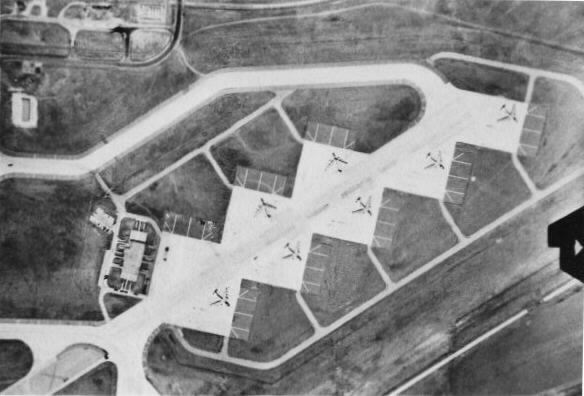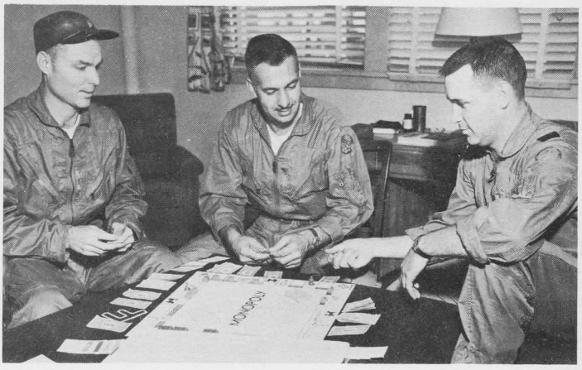On Alert
A brief history of the Lincoln AFB alert program 1957 - 1965
A B-47 crew scrambles during an alert exercise - Cold War Infrastructure of SAC-U.S. Army Corps of Engineers 1999
From 1957 until the end of combat-ready operations in 1965, several Lincoln B-47 bombers and KC-97 tankers were readied for quick response to any Soviet attack. Strategic Air Command rules required bombers to be airborne within 15 minutes of the first whine of the klaxon and the crews were constantly drilled. Loaded with nuclear bombs, this hair-trigger alert was designed to put the maximum amount of bombers in the air and give credibility to the American nuclear deterrent in the face of Soviet missile technology.
Sputnik and the vulnerability of SAC bombers
In the middle 1950s America amassed a huge bomber fleet mainly consisting of B-47s but was slowly being upgraded by B-52 bombers. As the manned bomber was at the time the only feasible strategic weapon capable of delivering nuclear weapons there was no absolute need for an alert force given that even jet bombers took several hours to attack and the development of the Distant Early Warning radar installations in the north of Canada gave ample notice of any Soviet aggression. Yet a change was in the air.
In October 1957, Sputnik, the world's first artificial satellite was launched by the Soviet Union. While the world marveled at the scientific achievement, American defense planners worried over the rocket that put the satellite into space. The R-7 rocket had the capability to carry a huge payload extremely long distances, suddenly putting the United States in danger of a sudden missile attack for the first time. Whereas bombers took several hours, Intercontinental Ballistic Missiles (ICBMs) could potentially destroy targets in minutes.
The manned bomber, exposed to the environment, its slower reaction time, and grouping on crowded SAC bases suddenly made it very vulnerable. While American ICBMs were beginning testing (later leading to the Atlas-F to be based at Lincoln) they were still a distant practical weapon. The only choice SAC had was to develop a hair-trigger alert program for its bombers for survivability.
SAC's Alert Program
SAC history documents put the beginning of an alert program back in 1956 and before Sputnik in 1957, testing the idea at a handful of bases. At Lincoln AFB itself alert barracks were set up within the Transient Officer's Quarters near the base dispensary. These were the closest practical barracks available to the flightline although they were in fact near the BX and therefore across Oak Creek. A siren system on base could be activated and officers on alert would scramble to vehicles and drive to their awaiting bombers. Lincoln's experiments with the alert concept included using a bus to get to the flightline (however this was too slow) and some faster automobiles from Lincoln car dealerships were leased to provide a stop-gap until dedicated Air Force vehicles could be deployed. Because of the rapid attack capability poised by Soviet missiles it was decided that better-protected housing right near the flightline was needed.
An interim solution included the shipment of five 50-foot trailers to sit aside the Lincoln flightline but a permanent solution was soon planned.
In 1956 even before Sputnik SAC began planning for alert aprons or special areas set aside for the rapid deployment of bombers. Several techniques were attempted until a definitive "Christmas tree" set up became the ultimate alert apron of SAC. Within these trees, concrete branches stretched out just far enough to allow for parking of a single bomber. Lincoln's own "Christmas tree" is shown below.

Photo thanks to Robert Loffredo
Construction at Lincoln
While many other SAC bases merely built on "branches" attached to alert areas from runways, it was decided in a unique case at Lincoln to actually build the alert apron onto the NW-SE runway effectively closing that runway to traffic. (It has been said that in the early 60s the other end of the runway was utilized for drag races). As seen above, there were 8 "notches" and these were occupied interchangeably by 98th Bomb Wing and 307th Bomb Wing B-47s. Mike Gingrich of the 307th BW notes that the north apron was utilized as an overflow alert area as well, to the south of that sat the tankers. Another alert area was set up south of Base Operations on the southern end of the flightline.
Molehole?
A 150-man (one of the largest in SAC) alert building was constructed during 1960 directly attached to the alert apron. The "Molehole" term is derived from the fact that much of the building sits below ground to help protect it against attack. The eight aircrews spent a period of time in these living quarters always ready to scramble to their bombers until their rotation was over. In fact the 98th and 307th Bomb Wings were reorganized with a fourth squadron in 1959 to support the alert mission (rotating from alert, rest, training, flying) and the full authorized compliment of crews were soon staffed (The 424th and 415th Bomb Squadrons shared aircraft with the rest of the wings, however numbers of B-47s at Lincoln varied over the years).
On Alert
To keep airmen trained and ready for alerts, SAC headquarters often dispatched alert exercise messages to its bases. These exercises ranged from Alpha, Bravo, Coco and Delta. Alpha exercises included the crews scrambling to their plane while Bravo included the start up of the aircraft. Coco exercises involved the aircraft taxiing to the runway and readying for takeoff before the exercise would be called off. These alerts were quite rare, but Delta exercises were the rarest as they sent the aircraft into the air. In the 1950s, the Jet Scoop reported the codename "Serious" meant the crews were going to war.
While many other SAC bases merely built on "branches" attached to alert areas from runways, it was decided in a unique case at Lincoln to actually build the alert apron onto the NW-SE runway effectively closing that runway to traffic. (It has been said that in the early 60s the other end of the runway was utilized for drag races). As seen above, there were 8 "notches" and these were occupied interchangeably by 98th Bomb Wing and 307th Bomb Wing B-47s. Mike Gingrich of the 307th BW notes that the north apron was utilized as an overflow alert area as well, to the south of that sat the tankers. Another alert area was set up south of Base Operations on the southern end of the flightline.
Molehole?
A 150-man (one of the largest in SAC) alert building was constructed during 1960 directly attached to the alert apron. The "Molehole" term is derived from the fact that much of the building sits below ground to help protect it against attack. The eight aircrews spent a period of time in these living quarters always ready to scramble to their bombers until their rotation was over. In fact the 98th and 307th Bomb Wings were reorganized with a fourth squadron in 1959 to support the alert mission (rotating from alert, rest, training, flying) and the full authorized compliment of crews were soon staffed (The 424th and 415th Bomb Squadrons shared aircraft with the rest of the wings, however numbers of B-47s at Lincoln varied over the years).
On Alert
To keep airmen trained and ready for alerts, SAC headquarters often dispatched alert exercise messages to its bases. These exercises ranged from Alpha, Bravo, Coco and Delta. Alpha exercises included the crews scrambling to their plane while Bravo included the start up of the aircraft. Coco exercises involved the aircraft taxiing to the runway and readying for takeoff before the exercise would be called off. These alerts were quite rare, but Delta exercises were the rarest as they sent the aircraft into the air. In the 1950s, the Jet Scoop reported the codename "Serious" meant the crews were going to war.

Lincoln's alert barracks in 1968 after the Nebraska State Patrol took over the facility. The facility was among the larger alert facilities built within the Strategic Air Command.
From a Lincoln base guide, a flight crew plays a game during their stint on alert
Operations and Closure
The alert program became a staple of Lincoln AFB operations as it did with SAC bases worldwide. A SAC infrastructure history paper termed Lincoln as being "one of the most critical SAC bases during the early Cold War period" due to its large bomber fleet and capability. The emphasis was changing however and missile technology was being implemented. While the alert apron was being built in 1960, so too were Atlas-F silos across Eastern Nebraska. With the beginning of the Minuteman missile program in 1962 the days of the large-scale deterrent by B-47 fleet was numbered. By 1964 only 400 B-47s remained in service while Minuteman missile installations soared (eventually 1,000 silos were built). Lincoln B-47s stood on alert until November 1965 when the last nuclear weapons were removed from the base. Soon after the base closed and the apron stood empty.
In 1971 the mole-hole was quickly removed by the Lincoln Airport Authority as a runway obstruction (with the reactivation of the NW-SE runway). Today the concrete pads where the bombers sat remain but little else. The original alert building was torn down years ago and the pads are the only remnant of a time when nuclear war seemed so close that bombers stood ready 24 hours a day, 7 days a week to retaliate against any Soviet attack.
Interesting PDF documents on the SAC Alert Program
SAC Dispersal and Alert Concepts in 1961: Declassified USAF document
Alert Operations and the Strategic Air Command 1957-1991 SAC History Office
Strategic Air Command and the Alert Program: A Brief History 1957-1988
The alert program became a staple of Lincoln AFB operations as it did with SAC bases worldwide. A SAC infrastructure history paper termed Lincoln as being "one of the most critical SAC bases during the early Cold War period" due to its large bomber fleet and capability. The emphasis was changing however and missile technology was being implemented. While the alert apron was being built in 1960, so too were Atlas-F silos across Eastern Nebraska. With the beginning of the Minuteman missile program in 1962 the days of the large-scale deterrent by B-47 fleet was numbered. By 1964 only 400 B-47s remained in service while Minuteman missile installations soared (eventually 1,000 silos were built). Lincoln B-47s stood on alert until November 1965 when the last nuclear weapons were removed from the base. Soon after the base closed and the apron stood empty.
In 1971 the mole-hole was quickly removed by the Lincoln Airport Authority as a runway obstruction (with the reactivation of the NW-SE runway). Today the concrete pads where the bombers sat remain but little else. The original alert building was torn down years ago and the pads are the only remnant of a time when nuclear war seemed so close that bombers stood ready 24 hours a day, 7 days a week to retaliate against any Soviet attack.
Interesting PDF documents on the SAC Alert Program
SAC Dispersal and Alert Concepts in 1961: Declassified USAF document
Alert Operations and the Strategic Air Command 1957-1991 SAC History Office
Strategic Air Command and the Alert Program: A Brief History 1957-1988
References:
COLD WAR INFRASTRUCTURE FOR STRATEGIC AIR COMMAND: THE BOMBER MISSION
November 1999 Karen J. Weitze, Ph.D. for U.S. Army Corps of Engineers
Global Security - Air Force Facilites
http://www.globalsecurity.org/wmd/facility/bomber_alert.htm
Strategic Air Command and the Alert Program - A brief history
April 1988 SAC Headquarters - Office of the historian
http://www.siloworld.com/DOWNLOADS/SAC%20Brief%20History%20Reduced.pdf
COLD WAR INFRASTRUCTURE FOR STRATEGIC AIR COMMAND: THE BOMBER MISSION
November 1999 Karen J. Weitze, Ph.D. for U.S. Army Corps of Engineers
Global Security - Air Force Facilites
http://www.globalsecurity.org/wmd/facility/bomber_alert.htm
Strategic Air Command and the Alert Program - A brief history
April 1988 SAC Headquarters - Office of the historian
http://www.siloworld.com/DOWNLOADS/SAC%20Brief%20History%20Reduced.pdf